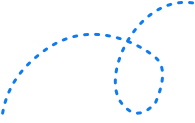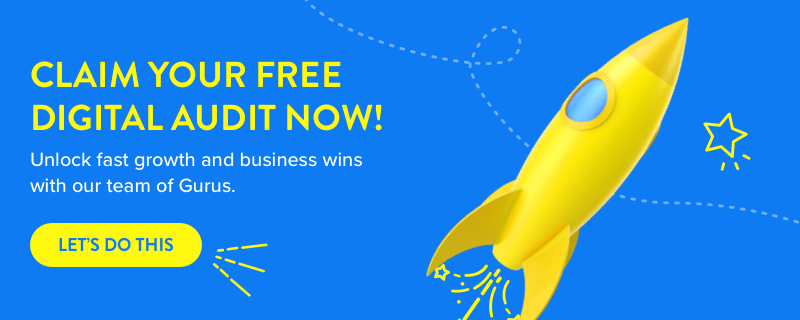How Much Should You Spend on Facebook Ads to Get Results? 

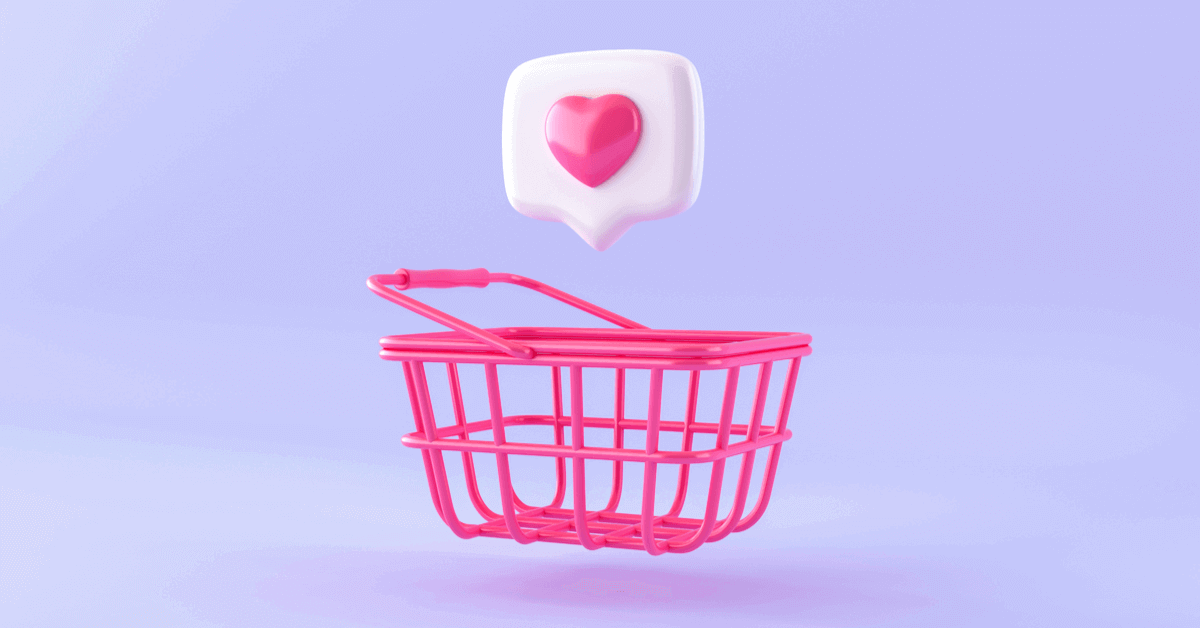
Your business is on Facebook. You’ve built up a solid presence and you’re posting content regularly to the platform. Now, you’re ready to up your game with Facebook Advertising.
Good choice. After all, Facebook Advertising is one of the most powerful and accessible marketing channels out there for businesses that are looking to grow leads and sales.
But when you’re just starting out, it’s tough to know how much you need to spend to reach your marketing goals.
If you’re too conservative, you might not be using the platform to its full potential. Spend too much, however, and you’ll blow your planned budget out of the water…or invest thousands without seeing any decent ROI.
The art of Facebook budgeting is an important part of nailing your paid social strategy. And in this post, we’re going to show you exactly how to budget your Facebook Ads to maximize your return on investment.
We’ll cover:
- The average cost of Facebook Ads for different industries
- Eight factors that affect how much your Facebook Ads cost
- How the Facebook auction process works
- 10 strategies to reduce your Facebook Advertising cost
- And ultimately, we’ll help you figure out if Facebook Ads are worth the investment for your business.
Let’s go.
How much does Facebook advertising cost?
Before you jump into budgeting your own Facebook Ads, it’s a good idea to know how much the average business is paying to advertise on Facebook.
While Facebook itself doesn’t disclose this data, other websites like Wordstream and AdEspresso have compiled valuable insights that give some indication of the average advertising costs for different industries.
According to Wordstream, the average CPC in Facebook Ads at $1.72. However, CPCs can vary wildly between different industries: for example, apparel brands have an average CPC of $0.45, whereas financial advertisers can expect to pay $3.77 per click.
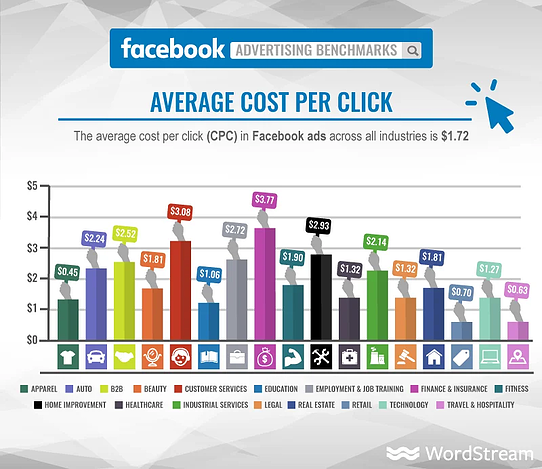
AdEspresso, on the other hand, breaks its Facebook Advertising cost benchmarks down by month. Based on the chart below, we can see that the average CPC sits at roughly $0.30 to $0.50 depending on the time of year.
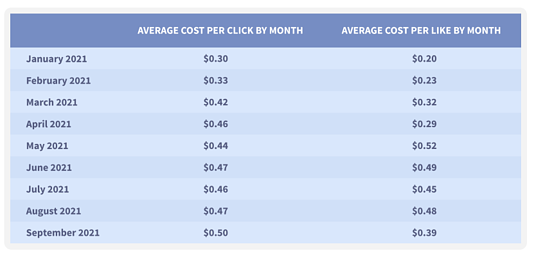
They also analyzed the difference in Facebook Ad cost averages between different campaign objectives. The data revealed that the average cost-per-click is far cheaper for lead generation ads than for conversion campaigns:
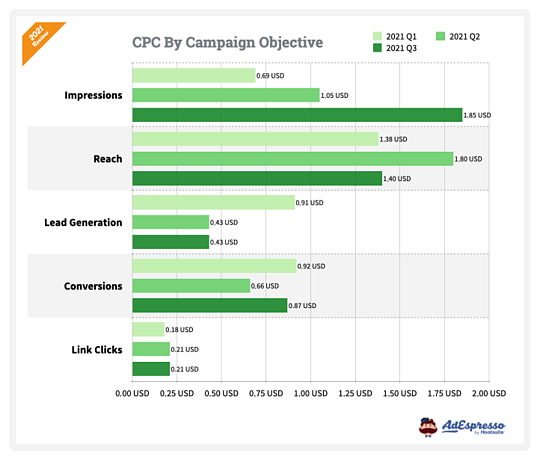
From looking at both of these studies, it’s safe to say that the average cost-per-click for any given Facebook Ad falls anywhere between $0.30 USD and $3.77 USD. Keep in mind though that these are ballpark figures, and your mileage may vary significantly depending on a number of factors (which we’ll delve into later).
How much should I budget for Facebook ads per day?
Even with the Facebook Ad budget benchmarks, it’s tough to say how much you should budget for Facebook Ads without actually running the ads yourself.
There are also A LOT of nuances that go into determining how much you should budget for your campaign. On the surface, a retargeting campaign may seem too costly to invest in compared to other campaigns that are focused on impressions or clicks. However, this is going to be your best bet if you want to convert your website visitors.
Based on our experience, we’d recommend setting aside a minimum of $1,500 a month for a Facebook Ad campaign. This evens out to a budget of roughly $50 per day.
With this Facebook Ads budget, you’ll have enough money to run multiple campaigns, test different ideas, and optimize your ads to improve ROI and lower CPC.
The eight factors that determine how much Facebook ads cost
The cost of Facebook Ads isn’t dictated by one factor in particular, such as your industry or your target audience. There is a multitude of considerations that Facebook takes into account when determining the cost of ads on the platform.
1. Your industry
The industry or niche is one of the biggest and most obvious factors that can influence your Facebook Advertising cost. As we saw from the Wordstream findings, some industries can cost significantly more than others.
If you’re in finance, customer service, or home improvement, you can expect to pay more than retail and apparel brands.
2. Ad bid
Facebook Ads Manager offers multiple bidding strategy options for advertisers. The one you choose will influence the overall cost of your ads, as well as how much control you have over your campaigns.
The two options are:
- Automatic bidding, or lowest cost bid strategy. This strategy is designed to help advertisers achieve the lowest possible cost per action. With this strategy, Facebook will use campaign performance data to automatically adjust an advertiser’s bids to make the most efficient use out of their budget.
- Manual bidding, or target cost bid strategy. If you’re aiming for a certain CPC or cost per action, then you might choose to go with manual bidding. This strategy optimizes your ads to reach your target cost, and can only be used for certain campaign objectives, such as app installs, conversions, lead gen campaigns, or product catalogue sales.
As a general rule of thumb, most advertisers start out with automatic bidding as it’s the cheaper option. Manual bidding is typically more expensive, but it’s ideal if you’re more experienced and want to maximize conversions.
3. Timing of your ads
When you choose to run your ads can also affect your overall Facebook Advertising costs. According to AdEspresso’s analysis of more than $636 million in ad spend, CPC is the lowest between midnight and 6AM, regardless of the time zone you’re in.
This is likely because fewer people are online at night, so advertisers turn off ads during these hours. If you’re running ads during this time, you can expect to pay less per click than ads that run from 7AM to 11PM.
4. Your audience targeting
Any time you shift your targeting, you should expect your ad spend to change along with it.
Here’s why.
Some audience groups are more expensive to advertise to than others, purely because more advertisers are competing for the same demographic.
Ads targeting women have a $0.15 higher CPC than ads targeting men, most likely because more brands are competing to reach this audience on the platform. Ads targeting people aged 55-65 are also more expensive than ads targeting younger users, as there are fewer people in this age bracket using the platform — which means higher competition for the brands that are trying to reach those people.
5. Ad placement
Facebook offers multiple ad placement options, including:
- Facebook newsfeed and video feeds
- Facebook Marketplace
- Facebook right column
- Messenger inbox
- Instagram feed
- Instagram Explore and Shop
- Facebook Stories, Instagram Stories and Instagram Reels
- Facebook Search
- Audience Network
More competitive placements, such as ad space in the feed or Stories, will cost more than a display in the right column on desktop devices.
6. Ad campaign objective
There are different ad objectives on Facebook that are designed to help advertisers reach their goals. These fall broadly into the categories of Awareness, Consideration, and Conversion, with specific objectives within each category:
Unsurprisingly, the ad objective options that are most valuable to businesses are also the ones that cost the most. Bottom-of-funnel objectives, such as product catalogue sales or store visits, will be more expensive than top-of-funnel objectives like awareness and reach.
7. Ad relevance
Facebook wants to show ads that are relevant to its audience. According to the platform:
“People prefer to see ads that are relevant to them. And when businesses show their ads to relevant audiences, they see better business outcomes. That’s why we consider how relevant each ad is to a person before delivering an ad to that person. Ads that are more relevant cost less and see more results. This leads to better experiences for people and businesses alike.”
The main way that Facebook measures relevance and quality is through ad relevance diagnostics. These are calculated based on an ad’s quality, engagement rate, and conversion rate. Ads with more relevance are less expensive to run, whereas ads that are less relevant cost more to run.
We’re not talking slight variations in CPC either. A few years ago, Hootsuite ran an experiment where it created two ads — one with a relevance and engagement score of 2.9, and one with a score of 8.
The former had an average CPC of $0.14.
Guess what the average cost-per-click was for the ad with the higher relevance score?
Just $0.03!
8. Season
Remember the AdEspresso data we looked at earlier?
The average cost-per-click for ads varies significantly based on the month you advertise in, thanks to seasonal trends and events.
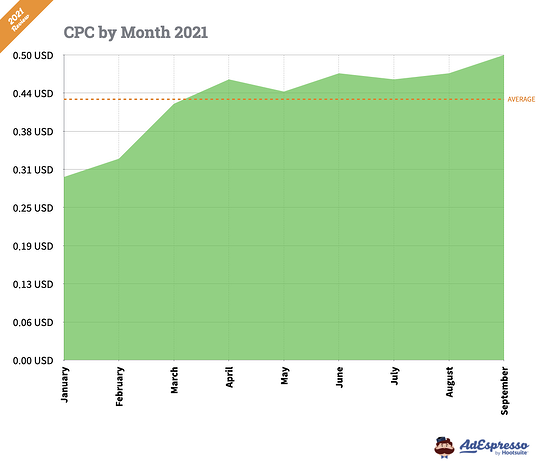
Want to run an ad during Black Friday when every other business is running ads? Expect your Facebook Ads costs to go through the roof. This is handy to keep in mind when planning your budgets, so you can adjust your Facebook ad spend accordingly.
Some of the key dates to keep in mind include:
- Valentines Day
- Mother’s Day
- Easter long weekend
- Father’s Day
- Black Friday
- Cyber Monday
- Christmas
- New Year’s Eve and New Year’s Day
How does the Facebook ads auction process work?
The Facebook ad auction process works much like Google Ads or any other pay-per-click platform.
To avoid overwhelming its audience with ads, Facebook limits the number of ad placements available. Advertisers need to ‘bid’ on a certain action, such as website clicks or ad impressions. The winner’s ad appears for that specific placement.
Here’s the process:
- Log on to Ad Manager and create your ad campaign
- Set your daily budget or lifetime budget
- Pick the actions you’re bidding on, such as impressions or reach
- Select your targeting for the ad
- Create your ad copy and upload your media content
- Submit the ad to Facebook for approval
Once your ad is submitted, Facebook will calculate the potential value of each ad based on three factors: the advertiser bid, ad relevance and ad quality, and estimated action rate on your ad. The ad with the highest value is the winning ad and gets displayed to the audience.
This means that your bid is only one of three factors that affect the outcome of the auction. If you optimize the other elements — ad relevance/quality and action rate — your ad will appear EVEN if you’re not the highest bidder.
10 strategies to reduce your Facebook Ads cost
Once you understand how Facebook Ads work, you can start working on strategies to shave down your spending.
These 10 strategies will help you lower Facebook Advertising costs, so you can maximize your ad spend and ROI from the platform.
1. Start small
When you start out with the Facebook Ads system, it’s tempting to pour in all the budget you have so you can start driving as much traffic as possible to your website.
Resist that urge.
It takes time to figure out what works with your audience, and which ads are most effective at helping you reach your goals. But more importantly, Facebook needs time to show your ad, gather data, and optimize it.
Start with a smaller budget and test a few variations to see what works. After about a week, you should have enough data to evaluate your ad performance and roll out your ad campaign. This way, you’ll be investing the big bucks into ad campaigns that you KNOW will perform well.
2. Split test your campaigns
Split testing is one of the best ways to optimize your ad relevance, quality, and estimated action rate.
Split testing (also known as A/B testing) involves different variations of the same ad to see which one performs better. You can split test all kinds of elements, including:
- Ad copy variations
- Ad copy length
- Call-to-action
- Image selection
- Image size
- Video thumbnail
- Use of emojis
Let’s take a look at this example from Mailchimp, where they tested two different images:
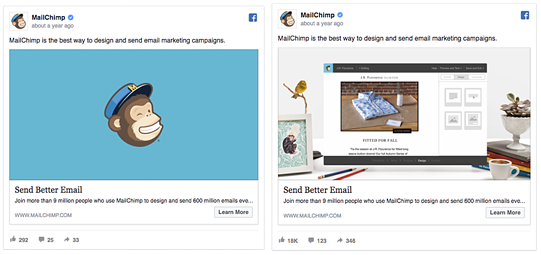
Here’s another example from Scoro, which revealed that adding an emoji to the ad headline led to a whopping 241% higher CTR:
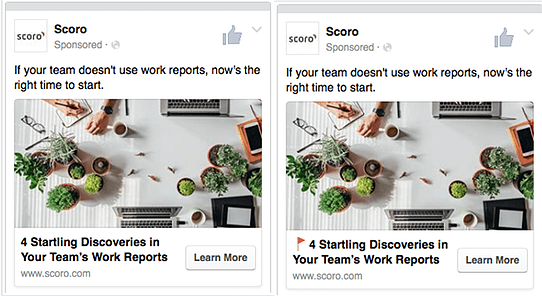
The key with A/B testing is to test one element at a time and keep everything else the same. If you try to test too many elements at once, you won’t know which change had the biggest impact on your ad performance.
Once you’ve run your split test, note down the findings of each split test, implement it in future ads, then rinse and repeat to create the best Facebook ads possible.
3. Keep an eye on your relevance score
Your relevance score is one of three big factors that influence the cost of your Facebook Ad. A high relevance score is a sign that audiences are engaging positively with your ad, and will go a long way in lowering your Facebook ad cost.
There are a few ways to improve your relevance on Facebook:
- Ensure you’re targeting the right audience. Even the most effective message will fall on deaf ears if it’s not reaching the right people. Use your buyer persona and Facebook Insights to narrow down your targeting, or create look-a-like audiences based on your existing customers.
- Use high-quality media. An eye-catching image or an engaging video will grab a user’s attention in the feed and encourage them to interact with your content. Make sure your visual media stands out and looks great on all devices, including mobile and desktop.
- Keep copy clear and succinct. Facebook likes ad copy that gets straight to the point. This isn’t just limited to your ad description either — having a sharp headline and call-to-action is just as important when it comes to inspiring your audience to take action.
4. Limit your ad frequency
On Facebook, quantity doesn’t equal quality. Showing your ad to the same people multiple times a day, every day, is a recipe for lower engagement and conversions — and higher ad costs.
Think about it. The first time you see an ad on your Facebook newsfeed, it’s new and fresh. The second or third time, you might still be interested and click to learn more. But by the tenth time? You’re not buying whatever that advertiser is selling.
Two things happen when your ad frequency gets too high.
One, it shows you’re not reaching enough new customers (or the ones you are showing it to aren’t converting). Second, you’ll have less interactions on your ad, which tells Facebook that your ad isn’t relevant. At this stage, you can bet that your advertising costs will start to increase.
Facebook recommends keeping your ad frequency capped at 3 to reach its full potential. Once your ad frequency goes above this amount, it’s time to revisit your campaigns and either adjust or pause them to lower this number.
5. Reduce the number of ad sets
Another common mistake advertisers make on Facebook is running too many ads at the same time.
Let’s say that two advertisers have a daily budget of $50. Advertiser A has 20 ads, while advertiser B has one ad set with three ads. With Advertiser A, that $50 budget needs to be spread across 20 different ads. With Advertiser B, the budget only needs to be spread over three.
The biggest challenge here is that your ads need to run for enough time and reach enough people before you can start gathering data on performance. If you have more ads, it’ll take a longer period of time to gain those insights — which leaves you more susceptible to wasted ad spend.
6. Refresh your ads on a regular basis
You should be refreshing your ads on a regular basis to ensure they don’t become stale and lose impact.
Keep in mind that this doesn’t mean scrapping your old ads and starting from scratch. Rather, this is an opportunity to build on your existing campaigns and implement learnings to improve performance. A new ad refresh is the perfect time to implement some of those learnings from your A/B test, or to revitalise a previous campaign with new content.
Plus, refreshing your ads also helps keep frequency scores low — another win for reducing Facebook costs.
7. Don’t tinker too much
One of the worst things any advertiser can do is constantly change or adjust their Facebook Ads.
At first, this might seem counterintuitive. After all, how are you supposed to improve performance if you’re not tweaking your campaigns?
Here’s the thing. The Facebook algorithm is actually pretty good at allocating budgets to the ad sets that are most likely to perform, and predict future performance. Focus on refining your ad creative, and let Facebook Ads optimize your advertising budget for the best results.
If you do want to make decisions based on data, try to base your decision-making on windows that are larger than 14 days to get the whole picture.
8. Segment your audience for each campaign
Facebook has incredibly sophisticated targeting capabilities — something you need to learn to take advantage of if you want to lower your advertising costs.
There’s no point trying to reach everyone with one ad campaign because your ad will be irrelevant for a large portion of that audience. And if your ad is irrelevant to a large portion of Facebook users, you can bet it’s going to cost you way more money than an ad that’s hyper-targeted and relevant.
Each and every campaign you run should have its own target audience and message. You can choose to segment your target audience based on different buyer personas or try to reach people at different stages of the marketing funnel. You’ll get more clicks and conversions AND lower your ad costs at the same time.
9. Use retargeting and remarketing
Retargeting and remarketing are two of the most powerful advertising tools that you have at your disposal.
Retargeting allows you to display ads to people who have already visited your website, while remarketing allows you to show ads to customers based on their interaction with your email campaigns.
These audiences have already been exposed to your brand, which means they’re more likely to be interested in your products and services. Because of this, retargeting and remarketing campaigns typically result in higher clicks and conversion — and much better ROI.
On top of website and email visitors, you can also use Facebook’s sources to retarget audiences that have watched one of your videos, interacted with your Instagram profile or Instagram Ads, or visited your Facebook page.
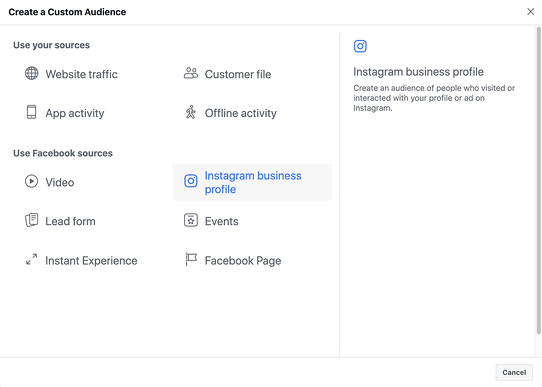
10. Put bid caps in place
Don’t want to spend more than $5 per conversion? Use a cost cap bid strategy.
Bid caps are a great last line of defence to prevent your Facebook Ad costs from blowing out of the water. However, there is a trade off: if you can your bid, you might end up missing out on valuable opportunities to reach your audience and drive more qualified traffic to your website.
Is Facebook Advertising worth the cost?
Facebook Ads is absolutely worth the cost because it allows you to reach your target audience where they spend their time online. Couple that with insane targeting capabilities and endless ad formats, and you have a powerhouse for clicks, conversions and sales.
If you’re looking at cost alone, Facebook Advertising can seem pretty expensive. After all, a daily budget of $50 per day translates to roughly $1,500 a month, which can be a lot — particularly if you’re a small business.
That’s why you need to look at ROI with any Facebook Advertising campaign.
For example, if you spend $1,500 a month on Facebook Ads but that $1,500 generates $30,000 in sales, you’re getting an ROI of 20:1. That means every dollar you invest is bringing in $20 in return. If your other advertising platforms are bringing in less ROI, then Facebook Ads is absolutely worth the cost. It’s also completely measurable: unlike traditional advertising, you know exactly how many people you’re reaching and how that’s translating to real traffic and sales for your business.
Another consideration to take into account is your audience. To get the most out of Facebook, you NEED to be leveraging its targeting capabilities to the fullest. Any less than that, and you’ll pay a lot to put your message everywhere but get nowhere in terms of ad spend.
Grow faster with a laser-focused Facebook Ads campaign
With the right Facebook Ads strategy, you’ll fast track business growth and turn clicks into dollars. It all starts with understanding how the Facebook Ad auction process works, then optimizing your campaigns for relevance and actions.
We know it’s a lot to take in, especially when you’ve got so many other tasks to juggle. That’s why countless businesses turn to OMG to launch and optimize profitable Facebook Advertising campaigns.
417% return on advertising spend. 200% growth in paid revenue.
These are real results we’ve generated for businesses using Facebook Ads. Now, we’re here to do the same for you. Best of all, it’s completely free to get started. Simply claim your free audit worth $2,000 today. No obligations — just results.

